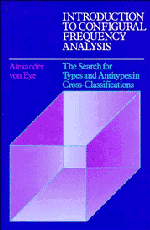 Introduction to Configural Frequency Analysis
Introduction to Configural Frequency Analysis from Part I - Concepts of configural frequency analysis
Published online by Cambridge University Press: 04 August 2010
This section gives a brief overview of CFA models. A CFA model is characterized by the assumptions the researcher makes when estimating expected frequencies. The second part of this book describes each model in more detail and gives numerical examples.
CFA performs multiple simultaneous or sequential tests to compare observed frequencies, o, with expected ones, e, estimated under some model. Significant differences between o and e indicate local associations beyond the ones assumed when estimating expected frequencies. For the estimation of expected frequencies methods from log-linear modeling can be used (see Bishop et al. 1975; Goodman 1978; Haberman 1978; Agresti 1984). However, the goals of CFA and log-linear modeling are basically different (cf. Krauth 1980a; Lehmacher 1980a, 1984). When applying CFA, the researcher wants to reject null hypotheses concerning single configurations. If null hypotheses can be rejected, types and antitypes may be interpreted. The focus of this interpretation is on the subjects who display patterns of states, or configurations that occurred more or less frequently than expected under some model.
When applying log-linear modeling, the researcher intends to identify the null hypothesis that provides the best fit to the observed frequency distribution. In other words, the researcher attempts to identify a set of relationships that explains the observed frequency distribution. When evaluating fit one refers to such statistical criteria as significance thresholds and to such philosophical criteria as parsimony.
To save this book to your Kindle, first ensure [email protected] is added to your Approved Personal Document E-mail List under your Personal Document Settings on the Manage Your Content and Devices page of your Amazon account. Then enter the ‘name’ part of your Kindle email address below. Find out more about saving to your Kindle.
Note you can select to save to either the @free.kindle.com or @kindle.com variations. ‘@free.kindle.com’ emails are free but can only be saved to your device when it is connected to wi-fi. ‘@kindle.com’ emails can be delivered even when you are not connected to wi-fi, but note that service fees apply.
Find out more about the Kindle Personal Document Service.
To save content items to your account, please confirm that you agree to abide by our usage policies. If this is the first time you use this feature, you will be asked to authorise Cambridge Core to connect with your account. Find out more about saving content to Dropbox.
To save content items to your account, please confirm that you agree to abide by our usage policies. If this is the first time you use this feature, you will be asked to authorise Cambridge Core to connect with your account. Find out more about saving content to Google Drive.